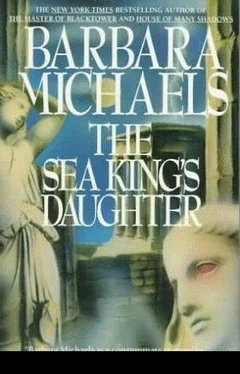Barbara Michaels - The Sea King’s Daughter
Здесь есть возможность читать онлайн «Barbara Michaels - The Sea King’s Daughter» весь текст электронной книги совершенно бесплатно (целиком полную версию без сокращений). В некоторых случаях можно слушать аудио, скачать через торрент в формате fb2 и присутствует краткое содержание. Жанр: Детектив, на английском языке. Описание произведения, (предисловие) а так же отзывы посетителей доступны на портале библиотеки ЛибКат.
- Название:The Sea King’s Daughter
- Автор:
- Жанр:
- Год:неизвестен
- ISBN:нет данных
- Рейтинг книги:3 / 5. Голосов: 1
-
Избранное:Добавить в избранное
- Отзывы:
-
Ваша оценка:
- 60
- 1
- 2
- 3
- 4
- 5
The Sea King’s Daughter: краткое содержание, описание и аннотация
Предлагаем к чтению аннотацию, описание, краткое содержание или предисловие (зависит от того, что написал сам автор книги «The Sea King’s Daughter»). Если вы не нашли необходимую информацию о книге — напишите в комментариях, мы постараемся отыскать её.
The Sea King’s Daughter — читать онлайн бесплатно полную книгу (весь текст) целиком
Ниже представлен текст книги, разбитый по страницам. Система сохранения места последней прочитанной страницы, позволяет с удобством читать онлайн бесплатно книгу «The Sea King’s Daughter», без необходимости каждый раз заново искать на чём Вы остановились. Поставьте закладку, и сможете в любой момент перейти на страницу, на которой закончили чтение.
Интервал:
Закладка:
Most archaeological sites are pretty boring, just low foundation walls, drab brown brick and gray stone, with dusty weeds growing up over the thresholds. Knossos has been restored by the excavator, Sir Arthur Evans; and although the purists criticize his restorations, claiming that he used more imagination than research, the result is so handsome you can’t condemn him. The palace is truly labyrinthine in size and complexity. The rooms, roofed and columned, are complete; the grand staircase really is grand, the queen’s bathtub is in place in her bathroom. And the colors! The queer Cretan columns, larger at the top than at the base, painted black and red; the faded terra-cotta of the giant storage jars; the soft blues and yellows of the painted walls. The frescoes are clean modern copies of the originals, which are now in the museum. Like most of Knossos, they have been restored-over-restored, according to some critics. But they give some idea of how gay and bright the place looked in its heyday. There are flying blue dolphins and golden griffins; processions of young men with long black curls falling over their shoulders and their waists pulled in by broad, tight belts; frivolous Cretan ladies in costumes that look like the latest Paris fashions, the skirts long and full and flounced, the bodices baring their breasts.
Perhaps the most famous fresco is the one of the bull leapers.
Hans liked that one.
“Achtung,” he exclaimed, or some vigorous German exclamation. “How could they do such dangerous thing? I would not jump over bull!”
“You might if the alternative was being killed,” I said. “Maybe the bull dancers were prisoners who were trained for the job.”
“Yes, yes, I have read the books that say so. But I doubt that it happened. Even, I doubt the picture when I see it! It is a fantasy.”
“No,” I said. “No, it could be done. It doesn’t require any more skill or coordination than modern-day gymnastics. The only difference is that it’s more dangerous. The mortality rate must have been high. But that didn’t seem to bother the Greeks. I wouldn’t choose you, though, Fritz. You’re too heavy. A bull dancer had to be light and lean-pure muscle.”
Like the man in my dream.
“Like you.” Fritz looked me over approvingly. “You would dance well with the bull, nicht?”
The big brown bull was in full charge, his head lowered. The three athletes were naked except for queer little calf-length boots and close-fitting loincloths, fastened at the waist by the broad, stiff belts that seemed to have been fashionable in Crete. One of them was standing behind the bull with her arms raised, as if she were about to catch the man who was doing a handstand on the bull’s back. His legs were flung back, and it was clear that he was about to somersault over the tail and land on his feet, behind the bull. The third of the three vaulters was just starting her leap. She had hold of the bull’s horns, and she was right in between them, you could see the points on both sides of her body. The technique couldn’t have been more clearly expressed in a games manual. The athlete grabbed the bull’s horns when he charged, and when he tossed his head back she vaulted up over his head, landed on his back, and jumped to the ground. That is, she did it unless she got caught on the horns.
Yes, I said “she.” Two of the athletes were girls. No mistake; not only were they shaped like girls, but they were painted a pale yellowish white, in contrast to the third athlete, who was reddish brown. Hans explained that coloring the men darker than the women was a convention in Minoan art. The Egyptians did the same thing, perhaps because the women usually stayed inside and protected their complexions from the hot Mediterranean sun.
I wondered if I could get a postcard of the scene. If so, I would send it to Mr. Barnes, the gym teacher who had refused to let me play baseball because girls were too fragile for such a violent sport.
This was one sport I wouldn’t have tried out for. Oh, it could be done; as I had said to Hans, it didn’t require any more coordination than a lot of the tricks gymnasts learn. Only here, if you slipped, you didn’t get up, rubbing a sore fanny, and try again. But the danger wouldn’t deter the bull vaulters, any more than it stops bullfighters and mountain climbers and Evel Knievel. Maybe the vaulters weren’t prisoners. Maybe they were kids who saw themselves as superstars, strutting down the stone-paved streets with everybody pointing and whispering and asking them for their autographs. And, as Hans said, there might have been a religious meaning to the game. That would strengthen an athlete’s nerve too. The bull was the sacred animal of Poseidon, the sea god, and the games might have been rituals in his honor. Remember the Minotaur, half man, half bull…
You see, I was thinking quite reasonably and coherently. All the while, however, another process was going on inside me. What had happened in the museum was only the overture before the main event, which began as soon as I set my sandaled foot on the soil of the city. The feeling was so strong that it overpowered my sense of congruity. It no longer seemed strange that I should find so many things familiar. It was as if I were two people in the same body. The real me- Sandy -was in control. She walked around and talked to Hans and admired the sights. But down underneath, in the dark places of my mind, someone else was waking up from a long, long sleep. That someone didn’t have a name. I didn’t dare give her one. But she knew this place, as she had known the gaming board and the clewbox.
“We” stood in the big central courtyard, and one of us remembered the games.
It was midafternoon by then, and hot. The sun beat down on the dusty gray surface, where a few hardy weeds survived the trampling of tourists’ feet. Along the four sides of the court were the walls and columns of the enclosing palace. There were quite a few sightseers. The ones who had come on the big gaudy tour buses were mostly over sixty and overweight. They had gray hair or white hair or no hair, except for a few of the women, whose bright-gold heads had come off a shelf in some shop. They huddled together like sheep, listening to the guide’s lecture. The younger tourists seemed to be students, for the most part. Some of them, with their long hair and short shorts, their legs and torsos bared, might have stepped out of the old frescoes-slim-waisted, brown young men.
“I” saw the tourists and the sunbaked earthen flooring. The other person in my mind saw great stone paving blocks, ominously stained; rows of spectators watching in breathless silence; the great brown bulk of the bull, and the man who stood waiting for its charge, hands raised and ready for the horns. His body was lean and brown, and his face was the face of the man in my dream.
Chapter 3
WHEN I WOKE UP THE NEXT MORNING I DIDN’T KNOW where I was. The events of the previous day were hazy and dreamlike, as if they had happened to some character in a book I had been reading. The hallucination in the great court, when I had seemed to see a color replay of the bull games, was my last coherent memory. The rest of the day was a series of isolated fragments.
Hans and I had explored the palace, met a couple of students from Denmark, and had supper with them. I remembered their faces; the names were gone. Afterward I must have found the house where I had rented a room… Yes, one ofthe memory fragments concerned the house, and the smiling, motherly Greek lady who owned it. She had shown me the room and brought me water so I could wash. After that-blank.
Calling the experience a hallucination reduced it to terms I could accept. Mentally I added another acceptable word. Sunstroke. Too much sun, unfamiliar food, illness-hallucinations. Reassured, I looked around the room.
Читать дальшеИнтервал:
Закладка:
Похожие книги на «The Sea King’s Daughter»
Представляем Вашему вниманию похожие книги на «The Sea King’s Daughter» списком для выбора. Мы отобрали схожую по названию и смыслу литературу в надежде предоставить читателям больше вариантов отыскать новые, интересные, ещё непрочитанные произведения.
Обсуждение, отзывы о книге «The Sea King’s Daughter» и просто собственные мнения читателей. Оставьте ваши комментарии, напишите, что Вы думаете о произведении, его смысле или главных героях. Укажите что конкретно понравилось, а что нет, и почему Вы так считаете.












